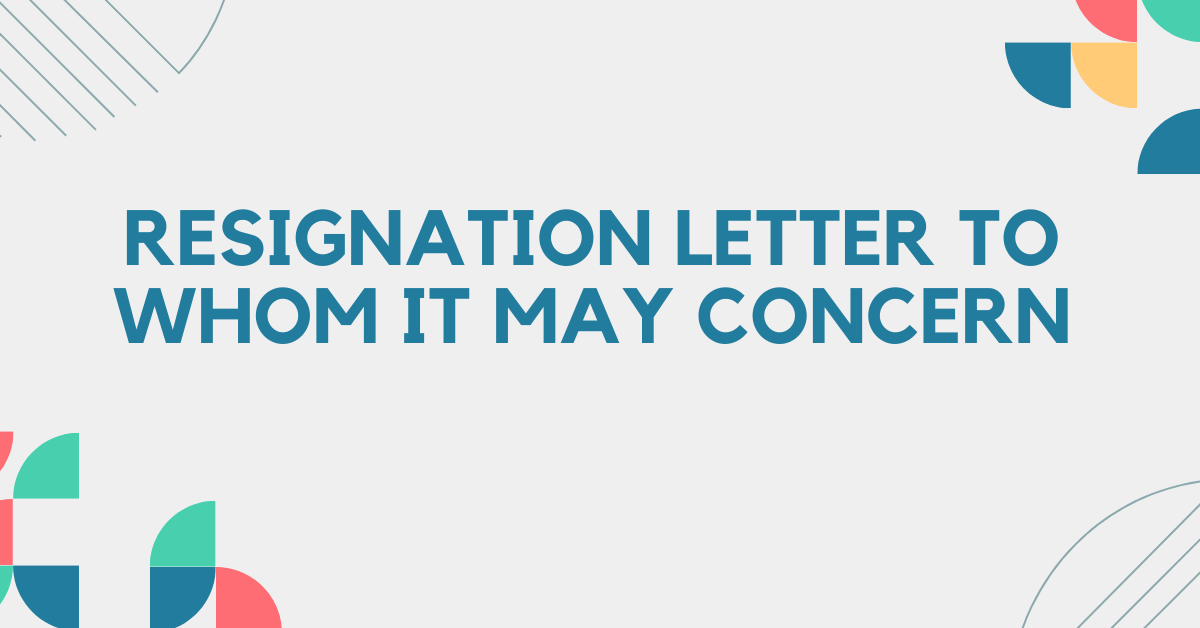When resigning from a job and the recipient is unknown, a “Resignation Letter to Whom It May Concern” is used. This letter serves as a formal notification of your decision to leave the position.
In this article, we will provide templates and examples of “Resignation Letter to Whom It May Concern.” These samples are designed to simplify the process of writing such a letter, ensuring clarity and professionalism in your communication.
Whether you are unsure of the recipient’s name or simply prefer a more general approach, our templates will guide you in crafting a concise and effective resignation letter.

Sample of a Resignation Letter To Whom It May Concern
[Your Name]
[Your Address]
[City, State, Zip Code]
[Email Address]
[Phone Number]
[Date]
[Recipient Name or Company Name]
[Company Address]
[City, State, Zip Code]
Dear Sir/Madam,
I am writing to inform you of my decision to resign from my position at [Company Name], effective [last working day, typically two weeks from the date of the letter].
I have enjoyed my time at [Company Name] and appreciate the opportunities for growth and development that have been provided to me during my tenure. However, I have decided to move on to new challenges and opportunities, and I believe that this decision is in the best interest of my career growth.
I want to thank you and the entire team at [Company Name] for your support and guidance during my time here. I have learned a lot from my colleagues and managers, and I will always cherish the memories and experiences I have gained.
I will ensure that all my current tasks are completed and that there is a smooth transition of my responsibilities. Please let me know if there is anything specific you would like me to do during my notice period.
Thank you once again for the opportunity to be a part of [Company Name]. I wish the company continued success in the future.
Sincerely,
[Your Name]
How to Write a Resignation Letter To Whom It May Concern
Writing a resignation letter To Whom It May Concern can be a challenging task, but with the right approach, you can ensure that your message is clear and professional. Here are seven steps to help you write an effective letter:

1. Understand the Purpose:
Before you begin writing, it’s important to understand why you are writing the letter. A resignation letter To Whom It May Concern is used when you are unsure of the recipient’s name or want to maintain a more formal tone.
2. Format the Letter:
Start by formatting your letter in a professional manner. Include your contact information at the top, followed by the date, and then the recipient’s information. Begin the letter with a formal salutation such as “Dear Sir/Madam.”
3. State Your Intent:
In the opening paragraph, clearly state that you are resigning from your position. Include the date of your last working day, which is typically two weeks from the date of the letter.
4. Provide a Brief Explanation:
In the next paragraph, provide a brief explanation for your resignation. You can mention reasons such as career growth, new opportunities, or personal reasons. Keep this section concise and to the point.
5. Express Gratitude:
Take a moment to express your gratitude for the opportunities and experiences you’ve had at the company. This shows appreciation for your time there and leaves a positive impression.
6. Offer Assistance:
During writing while in the closing paragraph, offer to assist with the transition process. This could include training your replacement or completing any outstanding tasks before your departure.
7. Close Professionally:
End the letter with a professional closing, such as “Sincerely” or “Best regards,” followed by your name and signature.
By following these steps, you can write a professional resignation letter To Whom It May Concern that leaves a positive impression as you move on to new opportunities.
FAQs about a Resignation Letter To Whom It May Concern
When it comes to writing a resignation letter To Whom It May Concern, there are often questions that arise. Here are some of the most frequently asked questions on this topic:
1. How do I address a resignation letter To Whom It May Concern
When addressing a resignation letter To Whom It May Concern, you can start with a formal salutation such as “Dear Sir/Madam.” This maintains a professional tone, even when you are unsure of the recipient’s name.
2. What should I include in a resignation letter To Whom It May Concern?
In a resignation letter To Whom It May Concern, you should include your intention to resign, the date of your last working day, a brief explanation for your resignation, and an offer to assist with the transition process.
3. Is it necessary to explain my reasons for resigning in a letter To Whom It May Concern?
While it’s not necessary to provide a detailed explanation for your resignation, it can be helpful to briefly mention your reasons. This shows professionalism and can help maintain a positive relationship with the company.
4. How should I format a resignation letter To Whom It May Concern?
Format your resignation letter To Whom It May Concern in a professional manner. Include your contact information at the top, followed by the date, and then the recipient’s information. Begin the letter with a formal salutation and end with a professional closing.
5. What should I do if I don’t receive a response to my resignation letter To Whom It May Concern?
If you don’t receive a response to your resignation letter, it’s a good idea to follow up with the company. You can send a polite email or make a phone call to ensure that your resignation has been received and to inquire about any next steps.
RELATED:
Resignation Letter from Full-time to Part Time
Resignation Letter to Take Care of Child
Resignation Letter Due to Toxic Work Environment
